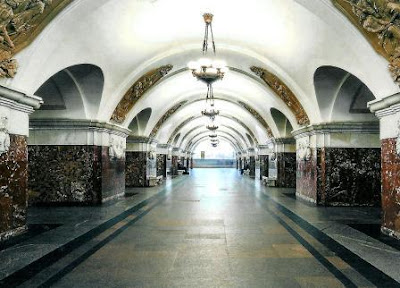Moscow’s underground transit system is now more than 80 years old, and carries up to 9 million passengers through more than 200 stations every day. It was built under Soviet rule and opened in 1935. Most of the architecture and decor meant to be a showcase for Soviet artists, ideals, and icons.
These are Krasnopresnenskaya and Arbatskaya stations.
RU-6600221, sent by Tanya.
Krasnopresnenskaya was opened on 14 March 1954. The station has red granite pylons with white marble cornices and 14 bas-reliefs. As the Presnya area of Moscow was the site of the Moscow Uprising of 1905 during the 1905 Russian Revolution, the station is decorated with artwork commemorating the events of the period. Eight of the bas-reliefs depict the events of the Russian Revolution of 1905 and the other six show scenes from the Russian Revolution of 1917. Statues of Vladimir Lenin and Joseph Stalin originally stood at the end of the platform, though these had been removed by the early 1960s. - in: wikipedia
Arbatskaya is a station of the Moscow metro. It was built in 1953 to replace an older station damaged in a German bomb attack in 1941. Since it was meant to serve as a bomb shelter as well as a Metro station, Arbatskaya is both large (the 250-m platform is the second-longest in Moscow) and deep (41 m underground).
The station represents an example of Stalinist baroque style, its opera clothes include white arched ceilings, bronze chandeliers, ceramic bouquets of flowers, red marble decorations, and glazed tiles.



No comments:
Post a Comment